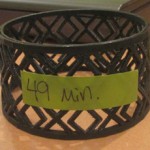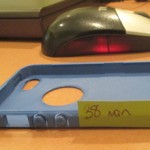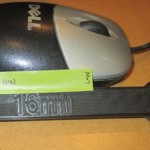We 3D printed some models to give visitors some idea of print quality and the print time involved in making a model. The models are from Thingiverse, an online cornucopia of user-generated files supported by MakerBot. You’ll have noticed these in the lab, and if you thought they were bracelets, don’t worry, you’re not alone. We added a wrench and an iPhone case to the zoo of 3D prints. Check out the photos below to see their print times.
Thingiverse is one of several places you can view, share and download 3D designs. For a more hands-on experience, you can check out the customizables or the Customizer (which requires a log-in). Creators can include details of their printing process, and other community members can leave comments or questions about design or technique.
MakerWare has a few settings you can alter that increase print quality, which will always increase print time. The three objects above were printed on low, which defaults to 300 microns, or .3mm, according to MakerBot. High has a layer thickness of 100 microns, or .1mm, as thin as a sheet of paper. For an illustrative experiment showing the difference in print times, check out Joe’s Makerbot Blog and Funbie Studio’s Blog. Joe printed on a Replicator 2X, and Funbie printed on a Replicator 2 like ours. Spoiler alert: print time jumped from 31 minutes to 88 minutes with the red knight chess piece, from the low setting to the high setting, with support and rafts.
When you visit during Open Shop, bring your camera, your questions and your designs, and prepare to meet some cool people.




